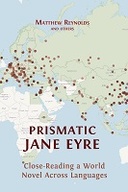Explore

Prismatic Jane Eyre
Matthew Reynolds, Annmarie Drury, Mary Frank, Paola Gaudio, Rebecca Ruth Gould, Jernej Habjan, Yunte Huang, Eugenia Kelbert, Ulrich Timme Kragh, Abhishek Jain, Ida Klitgård, Léa Rychen, Madli Kütt, Ana Teresa Marques dos Santos, Cláudia Pazos-Alonso, Eleni Philippou, Yousif M. Qasmiyeh, Céline Sabiron, Kayvan Tahmasebian, Giovanni Pietro Vitali
2023
0 Ungluers have
Faved this Work
Login to Fave
Jane Eyre, written by Charlotte Brontë and first published in 1847, has been translated more than six hundred times into over sixty languages. Prismatic Jane Eyre argues that we should see these many re-writings, not as simple replications of the novel, but as a release of its multiple interpretative possibilities: in other words, as a prism.
Prismatic Jane Eyre develops the theoretical ramifications of this idea, and reads Brontë’s novel in the light of them: together, the English text and the many translations form one vast entity, a multilingual world-work, spanning many times and places, from Cuba in 1850 to 21st-century China; from Calcutta to Bologna, Argentina to Iran. Co-written by many scholars, Prismatic Jane Eyre traces the receptions of the novel across cultures, showing why, when and where it has been translated (and no less significantly, not translated – as in Swahili), and exploring its global publishing history with digital maps and carousels of cover images. Above all, the co-authors read the translations and the English text closely, and together, showing in detail how the novel’s feminist power, its political complexities and its romantic appeal play out differently in different contexts and in the varied styles and idioms of individual translators. Tracking key words such as ‘passion’ and ‘plain’ across many languages via interactive visualisations and comparative analysis, Prismatic Jane Eyre opens a wholly new perspective on Brontë’s novel, and provides a model for the collaborative close-reading of world literature.
Prismatic Jane Eyre is a major intervention in translation and reception studies and world and comparative literature. It will also interest scholars of English literature, and readers of the Brontës.
This book is included in DOAB.
Why read this book? Have your say.
You must be logged in to comment.
